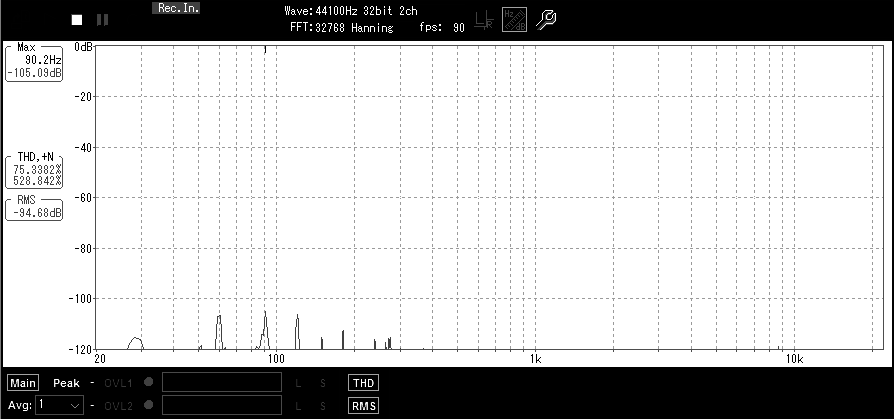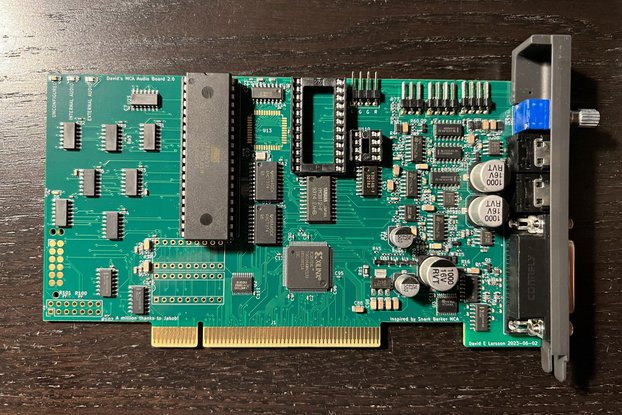Simple design, off-the-shelf components, low-noise audio path, SB 2.0 compatible
Designed by LABS in LatviaNo shipping info available.
Set destination country to see options
Shipping to starts at
Free shipping is available to !
Ships from
This item does not ship to .
More Info
Sign up to get notified when this product is back in stock!
Current PCB revision is G. Please refer to assembly manual for revision G cards by following 'Documentation' link at the end of this page. Always download the latest assembly manual before building t…
Read More…Blasterboard is an open-firmware ISA sound card for PC or compatible retro computers running DOS. The card is software compatible with Sound Blaster 2.0 and integrates high quality low noise audio path. It is capable of 8-bit mono digital sound playback in PCM and ADPCM formats, FM music playback via OPL2 chip, PC-Speaker playback and CD Audio playback using dedicated onboard connectors. Its CD Audio input connector can also be used as a line input for connecting any other sound hardware such as MIDI sound module. The card has 4-channel low noise analog mixer onboard with individual volume controls for all sound sources above, which provides about -94dB RMS noise floor.
Blasterboard is available in a DIY kit form or as a fully assembled and tested card.
There are 2 DIY kit options available (see pictures above):
Kit 0 is the minimal kit, which contains a PCB, custom made ISA bracket, mounting kit for the bracket and 2 wires for connecting CD audio and a PC-Speaker.
Kit 1 adds some specific components - ALPS volume pots, stereo audio socket, 1 resistor network, 2 ferrite beads, a rare 3.579545MHz crystal oscillator, a pre-programmed Atmega MCU + plastic DIP28 socket, MCP4901 8-bit DAC, YM3812 OPL2 chip and its Y3014B DAC.
The rest of the components are just a handful of common resistors, caps, diodes, logic chips, etc and thus are not included in any of the kits.
A full list of required components can be found in the assembly manual (see 'Documentation' link below).
My initial idea was to create a sound card using discrete off-the-shelf components to play some games from the past on my ancient 486. This machine had been collecting dust in the attic since the 90s, but after watching some retro gaming videos the nostalgic inspiration grew and I decided to give it a try. It was thoroughly cleaned, powered up and booted into MS-DOS. Some games were still installed on its hard drive, but there was a problem - the machine lacked a sound card. Buying one was not the way I wanted to go, but making one myself from scratch was a real dive into retro computing, so I got to work.
The main goal was to make a low-noise device with simple architecture and features I actually need:
I followed Sound Blaster 2.0 compatibility for its widest support of DOS games and simple design. To make it even simpler I dropped a sound recording ability and a gameport of the original card, but added a PC-Speaker input and a stereo CD/Line input, so the card could support any DOS game that produces any sound at all.
It took me about a month of intensive work before I was able to hear a legible PCM sound coming from the speakers. Despite it being just a heap of breadboards and wires, the excitement of hearing an explosion sound of the Duke Nukem 3D logo was over the top!
Two more months I was struggling with noise reduction, solving compatibility issues, prototyping and polishing software and hardware. And persistence did its job. Windows 98 finally detected the card automatically and named it officially "Sound Blaster or compatible".

At the end I came up with a neat looking sound card that answers the most DOS sound demands: CD audio, FM music, digital sound effects and PC-Speaker summed up to a single low-noise audio output. It can be connected to a nice sound system or headphones without introducing unwanted noise, which was so common for mass-produced sound cards from the DOS era.
Internal stereo CD/Line input accepts any sound source you want and feeds it to the Blasterboard's output. Audio output has around -94dB RMS signal-to-noise ratio. To compare with original Sound Blaster cards (measured with RMAA): SB 1.0/2.0 has around -46dB, SB Pro -52dB, SB 16 -77dB, SB AWE64 Gold -80dB.
The card has already been used on a quite amount of systems with lots of DOS software, including games like Doom, Heretic, Hexen, Descent, Quake, Warcraft, Blood, Duke Nukem, System Shock, Full Throttle, Gabriel Knight, Dreamweb, Goblins, Dune, Command & Conquer, Sim City, Ultima series, TES: Arena and many more as well as music trackers and demos.
The card's digital circuit uses discreet 74HC-series logic ICs. 8-bit sample playback is handled by Atmega MCU and MCP4901 DAC. Sample rates from 4kHz up to 62.5kHz are supported as well as ADPCM sample playback. Genuine Yamaha YM3812 (OPL2) chip and its DAC Y3014B are responsible for FM music playback. Stereo CD/Line input uses a noise cancellation circuit to reduce PC noise as much as possible, so the final signal is clean even on maximum volume.
All above signals go to the onboard mixer and are adjustable individually using 4 dedicated volume knobs from the back plane.
The card output's idle noise level is around -94dB RMS even when all volume levels are set to max and connected to its respective sources.

Card's output is a standard stereo mini jack connector. The output gives a loud and clean signal which is above the line-level at its maximum and also handles direct headphones connection.
Hardware settings are selected using jumpers:
*It is possible to select IRQ for the OPL2 chip. This option adds two extra hardware timers to a system. But since it was absent on the original SB card, it is not supported by any software I know. It is here mostly for custom experiments, so can be skipped during regular operation.
The card is intended to run perfectly on all PC or compatible retro systems. Please keep in mind that on faster machines (Pentiums and up) it will behave as the original SB 2.0 - some known games that are not intended for such CPUs may have a distorted sound or no sound at all. However, Blasterboard is more tolerant to faster machines than SB. Such picky ones as, for example, "Alone In The Dark" in DMA-mode or "Crystal" demo run perfectly on Pentium 166 MMX with Blasterboard, but failed to make any sound on the original SB 2.0 on the same machine.
I hope that Blasterboard will find its place in your retro PC system and you will enjoy building and using it as I did during its development.
No country selected, please select your country to see shipping options.
No rates are available for shipping to .
Enter your email address if you'd like to be notified when Blasterboard - a complete 8-bit ISA sound card can be shipped to you:
Thanks! We'll let you know when the seller adds shipping rates for your country.
| Shipping Rate | Tracked | Ships From | First Item | Additional Items |
|---|---|---|---|---|
|
:
|
Orders usually ship within 2-3 business days after payment. Please consider extra 4-6 days when ordering an assembled product.
Product: (5.00)
Documentation: (4.88)
Shipping: (5.00)
Communication: (5.00)
Juan Manuel | Oct. 20, 2023
Lukas | Sept. 13, 2023
Sergiy | July 5, 2023
Paul | July 1, 2023
Bruno | May 22, 2023
Michael | April 14, 2023
Thomas | Oct. 22, 2021
Jean | Oct. 16, 2021
No shipping info available.
Set destination country to see options
Shipping to starts at
Free shipping is available to !
Ships from
This item does not ship to .
More Info
Sign up to get notified when this product is back in stock!

$125.00
Free Shipping!

$35.00
Free Shipping!

$108.00
Free Shipping!

$25.00
Free Shipping!
By clicking Register, you confirm that you accept our Terms & Conditions
We recognize our top users by making them a Tindarian. Tindarians have access to secret & unreleased features.
We look for the most active & best members of the Tindie community, and invite them to join. There isn't a selection process or form to fill out. The only way to become a Tindarian is by being a nice & active member of the Tindie community!
